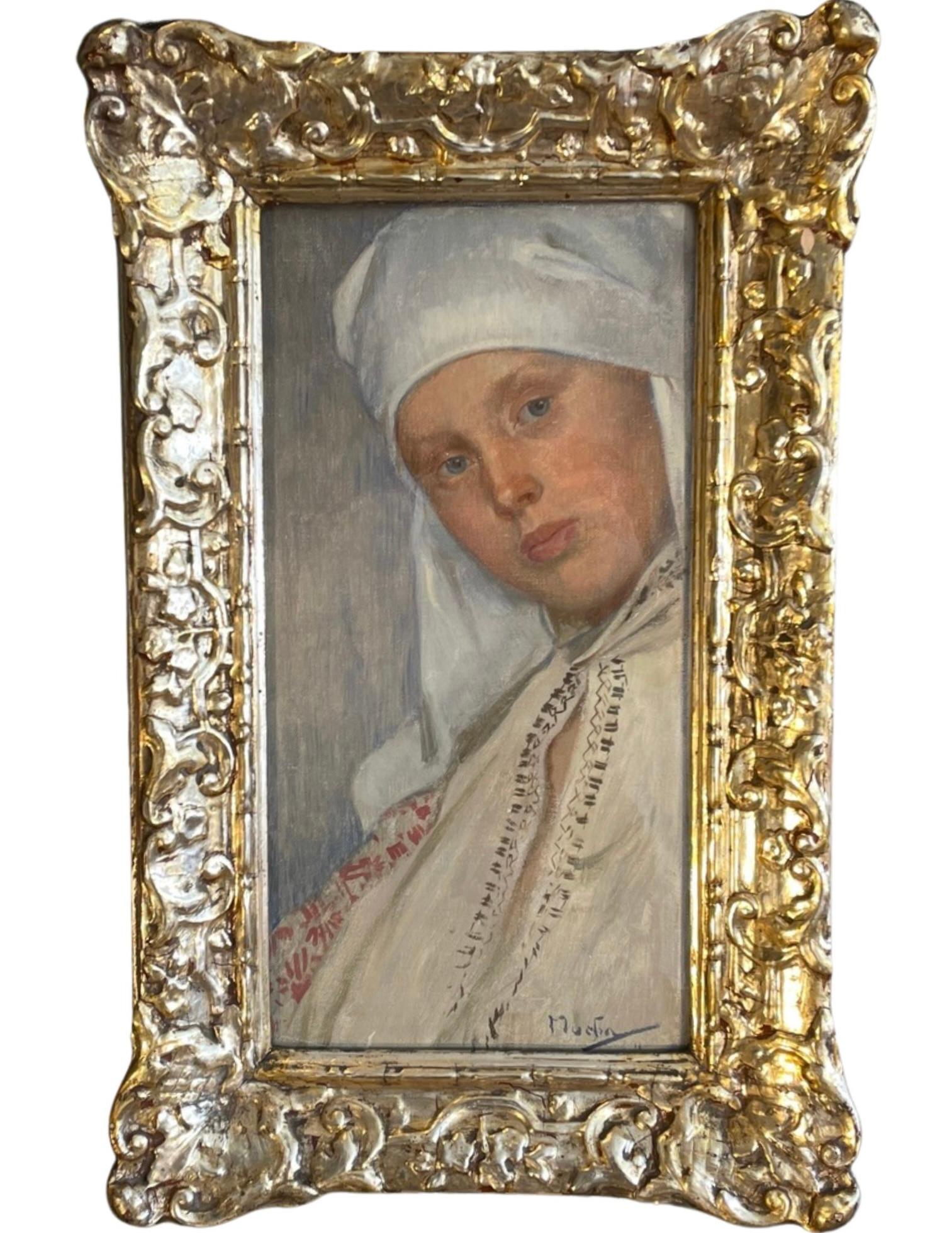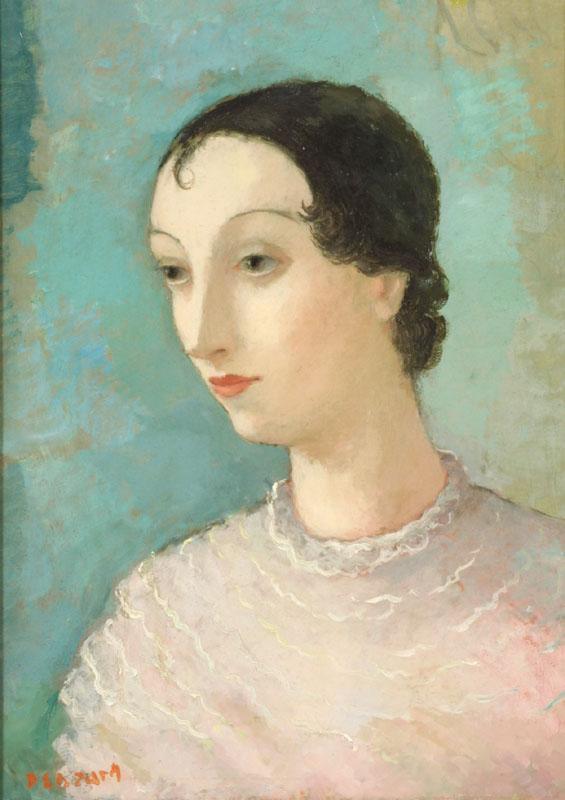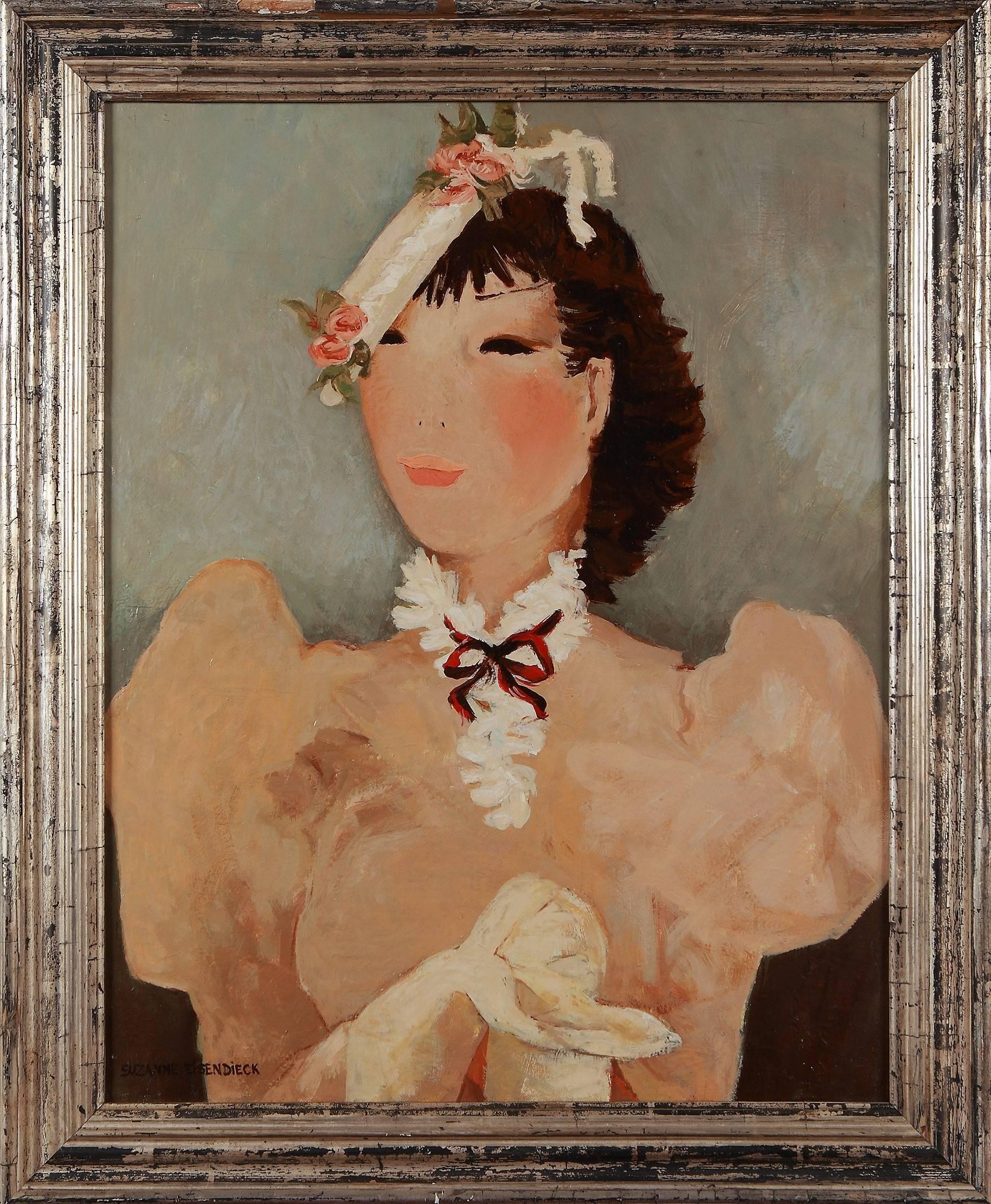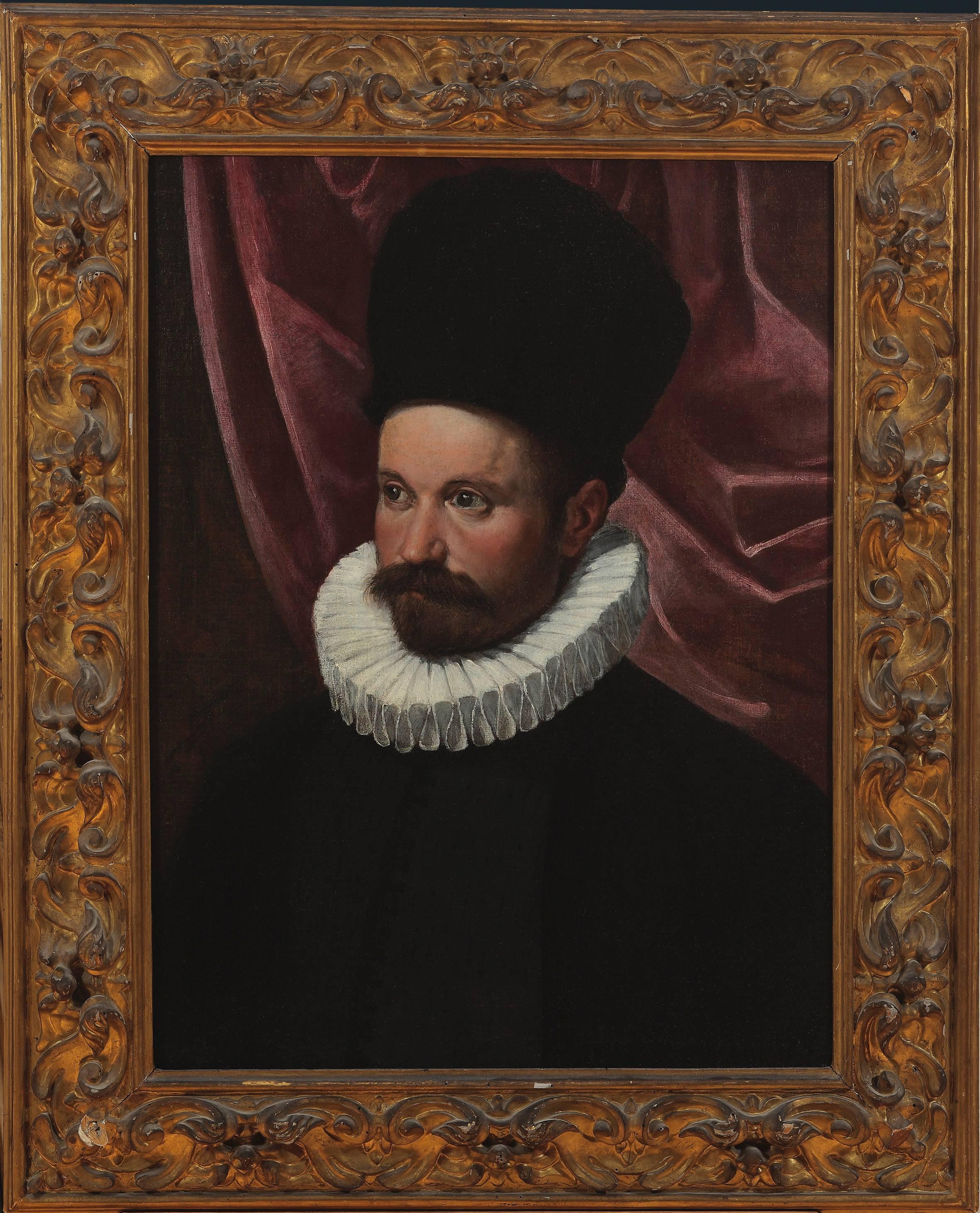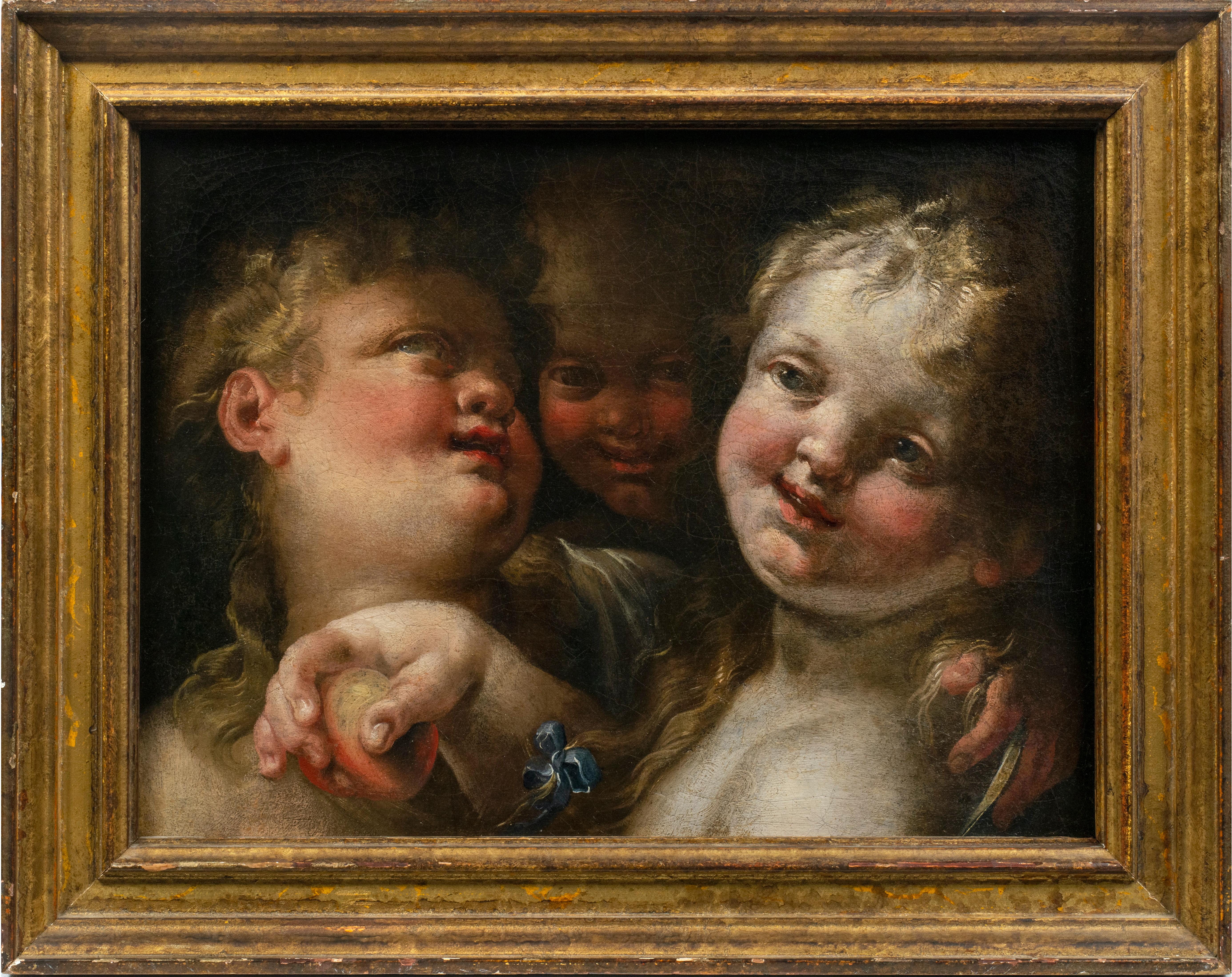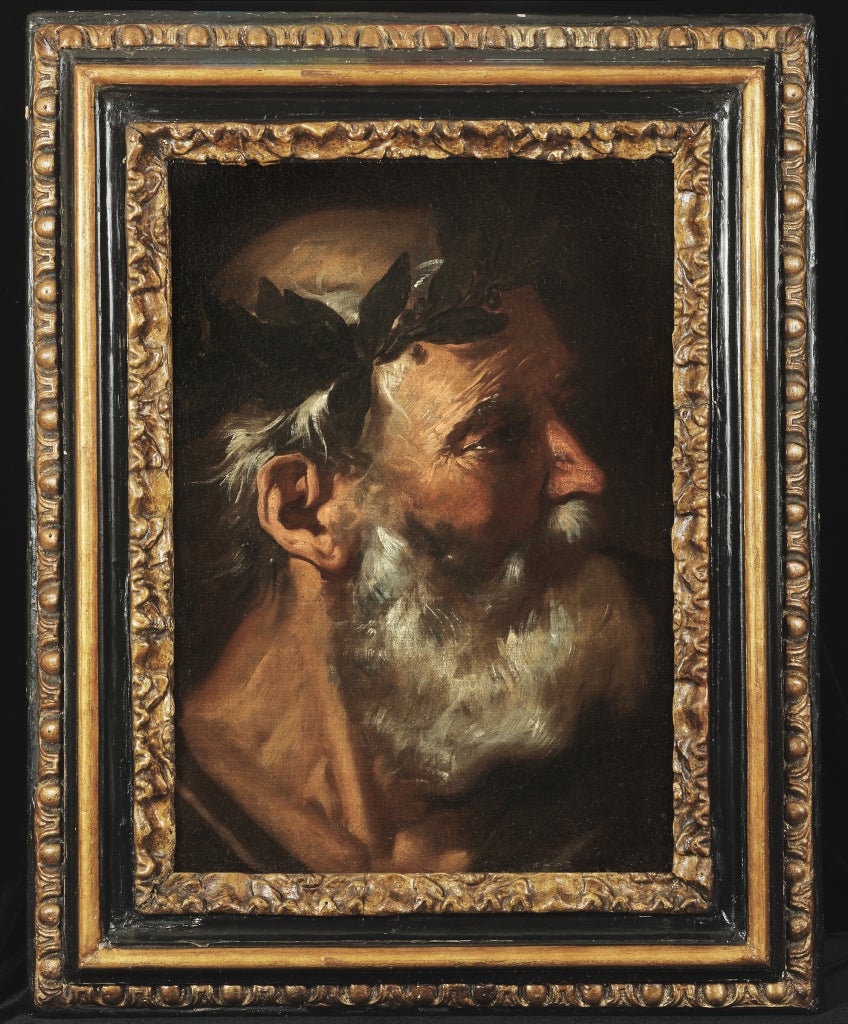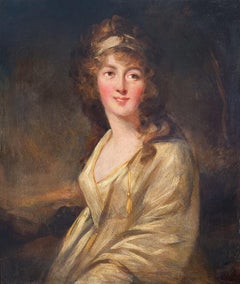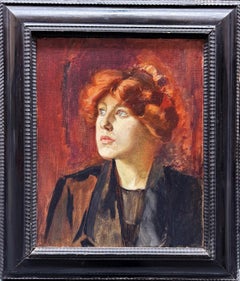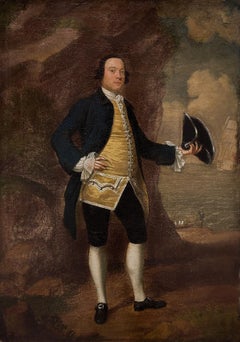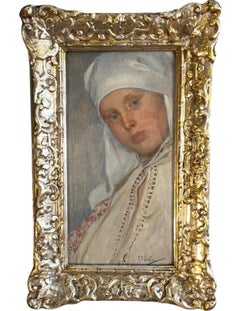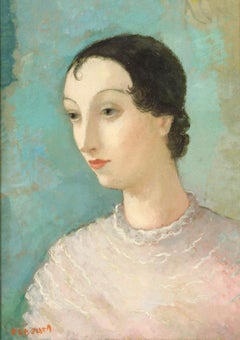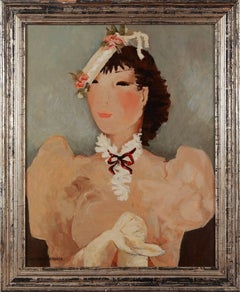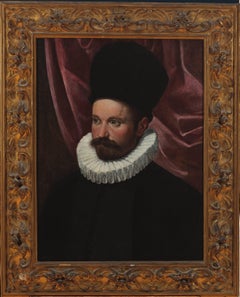Items Similar to Portrait of a Gentleman, 17th Century English Oil on Canvas
Want more images or videos?
Request additional images or videos from the seller
1 of 5
(Circle of) Mary BealePortrait of a Gentleman, 17th Century English Oil on Canvas
About the Item
Circle of Mary Beale
1633 - 1699
Portrait of a Gentleman
Oil on canvas
Image size: 30 x 25 inches
Contemporary gilt frame
Mary Beale was the daughter of a Suffolk clergyman.She married Charles Beale, an artist's colour-man, in 1652. Beale worked professionally from the mid-1650s, producing numerous portraits, particularly of her family and friends. She was a friend of Sir Peter Lely. Many details of her busy working life are recorded in the notebooks kept by her husband, Charles Beale, who acted as her studio assistant.
- Creator:(Circle of) Mary Beale (1633 - 1699, British)
- Dimensions:Height: 30 in (76.2 cm)Width: 25 in (63.5 cm)
- More Editions & Sizes:1 of 1Price: $6,514
- Medium:
- Period:
- Condition:
- Gallery Location:London, GB
- Reference Number:1stDibs: LU5244493991
About the Seller
5.0
Vetted Professional Seller
Every seller passes strict standards for authenticity and reliability
Established in 2007
1stDibs seller since 2014
80 sales on 1stDibs
Typical response time: 3 hours
- ShippingRetrieving quote...Shipping from: London, United Kingdom
- Return Policy
Authenticity Guarantee
In the unlikely event there’s an issue with an item’s authenticity, contact us within 1 year for a full refund. DetailsMoney-Back Guarantee
If your item is not as described, is damaged in transit, or does not arrive, contact us within 7 days for a full refund. Details24-Hour Cancellation
You have a 24-hour grace period in which to reconsider your purchase, with no questions asked.Vetted Professional Sellers
Our world-class sellers must adhere to strict standards for service and quality, maintaining the integrity of our listings.Price-Match Guarantee
If you find that a seller listed the same item for a lower price elsewhere, we’ll match it.Trusted Global Delivery
Our best-in-class carrier network provides specialized shipping options worldwide, including custom delivery.More From This Seller
View AllPortrait of Lady
Located in London, GB
Oil on canvas
Image size: 30 x 25 inches (76 x 63.5 cm)
Original gilt swept frame
This portrait is marked by its loose brushwork, which creates a sense of hazy nostalgia. Despite th...
Category
Late 18th Century Academic Portrait Paintings
Materials
Canvas, Oil
$19,540
Portrait of a Lady, Early 20th Century Oil
By Arthur Ambrose McEvoy
Located in London, GB
Follower of Ambrose McEvoy
Circa 1910
Portrait of a Lady
Oil on canvas
Image size: 20 x 16 inches (51 x 40.5 cm)
Original ebonised Frame
A stunning portrait of a lady with flami...
Category
Early 20th Century Portrait Paintings
Materials
Canvas, Oil
Portrait of a Woman
Located in London, GB
The lady averts her eyes from the gaze of the spectator, gently resting her chin on her hands. Her dress, makeup and hairstyle are drawn from the in-vogue fashion of 1930s Europe, ch...
Category
20th Century Art Deco Portrait Paintings
Materials
Canvas, Oil
Portrait of a Privateer
By Francis Hayman
Located in London, GB
Portrait of a Privateer
Francis Hayman
1708 - 1776
Oil on canvas
Image size: 20 x 14 inches (51 x 36 cm)
Contemporary style frame
Provenance
Charles Fleischmann Esq
Here, a small ...
Category
18th Century English School Portrait Paintings
Materials
Canvas, Oil
Sailor Smoking a Pipe
By Arthur David McCormick
Located in London, GB
Sailor Smoking a Pipe
Arthur David McCormick
Oil on canvas
Image size: 19 x 25 1/2 inches (48 x 65 cm)
Contemporary frame
Arthur David McCormick (1860–1943) was a notable British illustrator and painter, renowned for his landscapes, historical scenes, naval subjects, and genre scenes. Born in Coleraine, County Londonderry, he pursued his education at the Royal College of Art in London from 1883 to 1886.
McCormick’s career was marked by his contributions to various illustrated magazines, including the English Illustrated Magazine and the Illustrated London News. He participated in significant expeditions, such as Sir Martin Conway’s journey to the Karakoram Himalayas in 1892 and Clinton T. Dent’s expedition to the Caucasus Mountains in 1895. His illustrations from these travels were featured in Conway’s book “Climbing and Exploration in the Karakoram-Himalayas” (1894) and his own publication “An Artist in the Himalayas” (1895).
Throughout his career, McCormick illustrated nearly thirty books, focusing on travel and adventure themes. Some of his notable works include illustrations for Edgar Allan Poe’s “Tales of Mystery and Imagination” (1905) and Henry Newbolt’s “Drake’s Drum and Other Songs of the Sea” (1914). He was also a regular exhibitor at the Royal Academy from 1889 to 1938.
Navy Cut Sailor Work...
Category
20th Century English School Portrait Paintings
Materials
Canvas, Oil
Portrait of a Young Man Oil Painting Celebrated 20th Century Artist
By Oliver Messel
Located in London, GB
Oliver Messel
1904 - 1978
Portrait of a Young Man
Oil on canvas, signed and dated 'Oliver Messel 1930' (on the stretcher)
Image size: 30 x 25 inches (76.2 x 63.4 cm)
Original frame
Oliver Messel was born to Leonard and Maud Messel, née Sambourne, on the 13 January 1904 and was the youngest of three children. The family moved to Nymans, the Messel family home in Sussex, from nearby Balcombe in 1915. The house remained in the family until 1953 when it was bequeathed to the National Trust, following a fire in 1947 which destroyed a large portion of the house.
The Messels originated from a line of German Jewish bankers on Leonard’s side, however, both family lines boast a number of artistic influences, including Maud’s father. Maud was brought up at 18 Stafford Terrace, Kensington (now known as the Linley Sambourne House Museum), amongst collections of antique porcelain and eighteenth-century furniture, and with a host of artistic visitors such as Henry Irving and Oscar Wilde.
Oliver’s own upbringing appears to be influenced by his mother's, as the Messel family were also affiliated with artists and writers and were keen collectors of art, filling their home with textiles, paintings and collections of European and Asian fans from travels abroad. It was amongst such treasures that Oliver, Anne and Linley spent their childhood, in addition to the beauty of Nyman’s extensive gardens.
Oliver was schooled at Eton but rather than going up to university was encouraged by family friends, gallery owner Archie Propert and painter and sculptor Glyn Philpot, to attend art school. In 1922 he enrolled at the Slade School of Fine Art in London, where he studied under Henry Tonks. Here, he met the artist Rex Whistler with whom he remained firm friends until Whistler’s death in WW2.
Upon leaving the Slade in 1924 Oliver was apprenticed to the studio of portrait artist John Wells, where he learnt various Old Master painting techniques, and met artists such as Jacob Epstein, Augustus John and William Orpen.
Whilst at the Slade Oliver developed his interest in Papier Mâché masks, a pastime popular amongst many art students at the time. Whilst apprenticed to artist John Wells several of Oliver’s masks were exhibited at the Claridge Gallery, London, alongside pieces by Whistler and other young artists. These were seen by Serge Diaghilev, director of the Ballet Russes, and Charles B. Cochran, a theatrical producer, both of whom made Oliver offers of work.
His first job in the theatre was creating masks for the Ballets Russes’ Zéphyr et Flore, 1925, designed by the French artist Georges Braque, followed by numerous musical revues for Cochran, including Wake Up and Dream!, 1929, with music by Cole Porter. It was during these revues, working with Porter and Noel Coward, that Oliver also began to design headdresses and costumes. In 1932 he was rewarded with his first full commission to design both costume and sets for Helen!, directed by Max Reinhardt. The production design is still celebrated today for its innovative approach and ground-breaking ‘white on white’ aesthetic, which referenced ‘Greek temples, Rococo drapes, Baroque colonnades and Louis XIV carousels’.
The success of Helen! led to further offers within the theatre including Reinhardt’s version of A Midsummer Night’s Dream at the Old Vic in 1937, starring Vivien Leigh as Titania and Robert Helpmann as Oberon, the Jean Cocteau play The Infernal Machine in 1940, and Christopher Fry’s translation of Jean Anouilh’s Ring Round the Moon, 1950.
One of Oliver’s best-known productions during this period was the Russian ballet The Sleeping Beauty, performed by Sadler’s Wells Ballet in 1946 at the Royal Opera House, Covent Garden. Encompassing over 200 costumes and four set changes, Oliver’s romantic designs were celebrated for bringing colour back to post-war London, and variations on his designs are still used today. Additional designs for the ballet included Comus in 1940, for which he was released from war duties, and Homage to the Queen, choreographed by Frederick Ashton and performed in 1953 for the Queen’s coronation.
His first opera was in 1940 for Mozart’s Die Zauberflöte at the Royal Opera House, followed by a series of productions at the newly founded Glyndebourne Opera House in Sussex, for which Oliver also designed the proscenium arch. He triumphed in 1956 designing a season of four different productions for their Mozart bicentennial, also providing illustrations for the programme covers.
His popularity also spread beyond theatre to film, were he worked on over eight different feature films including Romeo and Juliet, 1936, directed by George Cukor. During a three-month research trip to Italy Oliver collected over 3,000 reference images including postcards of artwork by Piero della Francesca, Giovanni Bellini and Leonardo da Vinci, along with prints and photographs of textiles and architectural features.
A production of Gabriel Pascal’s Caesar and Cleopatra, 1946, starring Vivien Leigh and Claude Rains, was celebrated for Oliver’s ability to recreate the opulence and luxury of ancient Egypt under the constraints of wartime rationing. Such was his skill that Vivien Leigh in a letter to Oliver declared that “I have of course told Pascal that nobody in the world must do the costumes except you.” He was later nominated for an Academy Award for his work on his final film Suddenly, Last Summer, 1959; an adaptation of Tennessee Williams’ American Southern Gothic mystery.
Having started his artistic career as a portrait apprentice, capturing the faces of family and friends, Oliver continued to develop this practice until the end of his life. His style is said to have been influenced by Glyn Philpot, the Messel’s family friend who encouraged Oliver from an early age in his pursuit of art and design. His most prolific period came in the 1950s during which he produced over 50 portraits, which were shown in exhibitions in New York, London and Barbados.
The exhibitions included both well-known faces and anonymous sitters captured on Oliver’s travels, and a number of these works have entered private collections. He continued to paint after moving to the Caribbean in 1966, capturing society figures and the rich and famous including fashion designer Carolina Herrera and Bianca Jagger. His style remained unchanged throughout his career, using the same soft painterly strokes and subtle palette as in his theatre designs.
By far his greatest contribution in addition to theatre and film was Oliver’s interior and architectural designs.
Another, much celebrated commission included Rayne shoe shop in Old Bond Street, where he created jewel-like interiors using the same practice of scaled models as his set designs. Other notable interior designs include those for Norwich and Bath Assembly Rooms, Flaxley Abbey in Gloucestershire, Rosehill Theatre in Cumbria and the Reader’s Digest offices in Paris.
However, upon moving to Barbados in 1966, Oliver embraced a new career envisioning architectural concepts for private houses, hotels and public buildings, utilising his experience with interior design to furnish them with bespoke items of furniture and textiles. His first project was Maddox, the deserted eighteenth-century plantation house bought by himself and his partner Vagn Riis-Hansen in 1964. The existing building and gardens were remodelled to Oliver’s designs embracing an inherent theatricality with views out to sea. These were framed by terraces and verandas which extended out from the living rooms creating what is often referred to as a Caribbean style of ‘indoor-outdoor’ living. For the woodwork he used a shade of green that is now known as ‘Messel green’ and often associated with the island of Barbados.
Oliver was born into a wealthy family; he travelled extensively and was exposed to art and culture from a young age. A privileged youth, his name is often mentioned amongst the ‘Bright Young Things’, for whom costume parties at country houses and jaunts to Europe on a whim became a thing of fable. This informal group included people such as Cecil Beaton (a life-long friend whom Oliver first met at Eton), Lord Berners, Noel Coward, John Betjeman, Harold Acton, Nancy Mitford, Edith Sitwell, Stephen Tennant...
Category
20th Century Modern Portrait Paintings
Materials
Canvas, Oil
You May Also Like
'Obraz-Divka' (The Girl) by Alphonse Mucha - Original Mucha Portrait Painting
By Alphonse Mucha
Located in Carmel, CA
The American Art Gallery takes immense pride in offering "The Girl - A Study for the Slav Epic," an authentic original work by the celebrated Art Nouveau icon, Alphonse Mucha. Dating...
Category
1910s Art Nouveau Portrait Paintings
Materials
Canvas, Oil
Oil on Canvas "L' Espagnole" by Dietz Edzard, 1935
By Dietz Edzard
Located in Berlin, DE
Dietz Edzard ( German/French 1893-1963 ). Oil on canvas, 1935. With the artist's signature stamp at lower left. Framed.
Property of the Estate of Dr. Max Stern sold for the benefit o...
Category
1930s Post-Impressionist Portrait Paintings
Materials
Canvas, Oil
Suzanne Eisendieck "Chapeau Printanier. La Parisienne" Oil Painting on Canvas
By Suzanne Eisendieck
Located in Berlin, DE
Oil on canvas, circa 1950, by Suzanne Eisendieck ( 1906-1998 ) Signed lower left: SUZANNE EISENDIECK
Dimensions: 22.04 x 17.51 in ( 56 x 44,5 cm ). Framed: 26.37 x 21.45 in ( 67 cm x...
Category
1950s Post-Impressionist Portrait Paintings
Materials
Canvas, Oil
Portrait of a Gentleman
By Ippolito Scarsella (Scarsellino)
Located in New York, NY
Provenance: Suida-Manning Collection, New York
Private Collection
Exhibited: Venetian Paintings of the Sixteenth Century, Finch College Museum of Art, New York, October 30-December 15, 1963, no. 31.
Veronese & His Studio in North American Collections, Birmingham Museum of Art, Oct. 1-Nov. 15, 1972, and Montgomery Museum of Fine Arts, Dec. 5-Dec. 31, 1972
Literature: Robert L. Manning, A Loan Exhibition of Venetian Paintings of the Sixteenth Century, exh. cat. New York 1963, cat. no. 31ill., as by Veronese
Stephen Clayton and Edward Weeks, eds., introduction by David Rosand, Veronese & His Studio in North American Collections, Birmingham 1972, as by Veronese, p. 38 ill.
Terisio Pignatti, Veronese, Venice 1976, I, p. 199, cat. no. A225, II, fig. 908, as attributed to Veronese
Terisio Pignatti and Filippo Pedrocco, Veronese; catalogo completo dei dipinti, Florence 1991, no. 54°, as attributed to Veronese.
Terisio Pignatti and Filippo Pedrocco, Veronese, Milan 1995, II, pp. 517-518ill., cat. no. A 56, under attributed paintings, by Veronese and workshop)
John Garton, Grace and Grandeur; The Portraiture of Paolo Veronese, London-Turnhout 2008, p. 237, fig. 77, cat. no. R16, as workshop of Veronese.
Scarsellino’s art is widely regarded as critical link between the Renaissance and the Baroque styles in Emilian painting; not only was he an important transmitter of the heritage of the Renaissance, but he was also open to innovative ideas, and was one of the earliest to experiment with the trend to naturalism that would become fundamental to art of the new century. Born around 1550, he received his earliest training from his father Sigismondo, an architect and painter; it was probably while working at his father’s side as a youth that he acquired the nickname Scarsellino, or “little Scarsella”. After absorbing the principles of his art in Ferrara and Parma, he went to Venice in 1570, staying for four years and working in the shop of Veronese. In the following decade, his art —especially in terms of its piety and its development of landscape— demonstrates a strong sympathy with that of the Carracci, with whom he worked in 1592-1593 at the Palazzo dei Diamanti in Ferrara. Maria Angela Novelli and later Alessandra Frabetti both propose that Scarsellino traveled to Rome, although such a trip has not been documented; if he did travel to Rome, it probably would have occurred during the years that Scarsellino’s colleagues Agostino and Annibale Carracci were there, that is, beginning in 1595 and until 1609. The last decades of Scarsellino’s career again involve stylistic experimentation, this time in a manner that would bring his work very close to the progressive figurative naturalism of Carlo Bononi and prepare the way for Guercino.
The present portrait of a distinguished gentleman had been long thought to be by Paolo Veronese and was in fact attributed to him by such distinguished connoisseurs as Adolfo Venturi and Wilhelm Suida. The portrait’s style is, however, distinct from Veronese’s, although clearly indebted to it, and the attribution to the young Scarsellino is wholly convincing. The painting would then date from the 1570s – a date confirmed by the costume the subject wears. The puffed hat that appears in the painting had a rather short-lived vogue in the early 1570s. One sees it in Giambattista Moroni’s Portrait of Count...
Category
18th Century and Earlier Baroque Portrait Paintings
Materials
Canvas, Oil
Three Angels
By Domenico Piola the Elder
Located in New York, NY
Provenance:
Robert L. and Bertina Suida Manning, New York, until 1996
Private Collection, USA
One of the leading artists in Genoa during the second half of the seventeenth century, Domenico Piola came from a successful family of artists, renowned for their many illusionistic ceiling programs throughout Genoese churches and palaces. A prolific draughtsman and painter, Domenico oversaw an extremely productive studio. In addition to his collaborations with numerous other artists, Domenico also provided many designs for book illustrations and prints that circulated throughout Europe, earning him international exposure and high acclaim in his own day.
As Dr. Anna Orlando has indicated (written communication), the present work is an early work by Piola, datable from the late 1640s. At this time the young artist came strongly under the influence of Castiglione and Valerio Castello, while admiring the works of Giulio Cesare Procaccini. Piola’s works from this period are exuberant and fluid, and the artist’s love of portraying children is evident from the angels and putti that populate both his altarpieces and more intimate paintings.
The present work depicts three angels...
Category
17th Century Baroque Figurative Paintings
Materials
Canvas, Oil
Head of a Classical Poet (Socrates?)
By Pier Francesco Mola
Located in New York, NY
Provenance:
Possibly Antonio Amici Moretti, Rome, 1690
Roy Clyde Gardner, Union, Mississippi, 1970s until 2004; by whom given to:
Mississippi Band of Choctaw Indians, 2004-2010
Lit...
Category
17th Century Baroque Paintings
Materials
Canvas, Oil
Recently Viewed
View AllMore Ways To Browse
English Gentleman
Peter Husband
Japanese Woodblock Prints Hiroshige
Jk Art
Keith Haring Pop Shop
Kobe Bronze
Lincoln Table
Magritte Original
Nude Erotica Painting
Rocky Mountain Prints
Santa Fe Bronze
Stallion Horse
Vintage Audubon Prints
Vintage Polaroid
1940s Woman Portrait
Audubon Plates
Bette Davis
Cartier Serve
